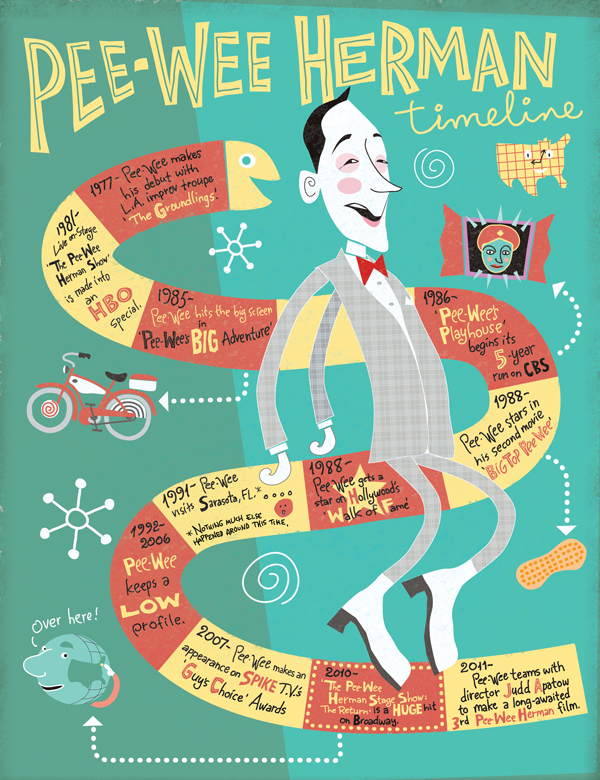Sometime during the early 80's, I first saw Pee-wee Herman on the David Letterman show, where he was a recurring guest. At the time, I really didn't know what to make of the character, an invention of improv comic Paul Reubens. But with every appearance, his brand of humor grew on me. The release of "Pee-wee's Big Adventure" made me a fan for life and "Pee-wee's Playhouse" was must viewing for my wife and I and later, for our kids.His recent "renaissance", with a wildly successful broadway show and plans for a new film, was welcome news to me and I'm sure to his many other fans. There were rumors of Johnny Depp taking over the role of Pee-wee in a movie sequel (only SLIGHTLY less ill-conceived than having James Brolin play the part) and there seems to be a grassroots internet movement to draft Jim Parsons ("the Big Bang Theory) as a replacement Pee-wee should that time arrive. As I see it, Reubens is, and will remain, the one and only Pee-wee Herman.
My "Bird Machine" illustration
Last week I posted an interview with the amazing gig poster artist and owner of "The Bird Machine", Jay Ryan. (Thank you, Jay!)
I usually head up my blog posts with an original illustration, but in this case, I decided that using my own illustration to head up a blog post featuring another artist's work didn't fit quite right, so after already doing an illustration based on "The Bird Machine", I shelved my own piece and uploaded a photographic treatment of Jay instead. So now I thought I'd post the original illustration on its own.
The bird was created in Illustrator and enhanced in Photoshop. The background was from a photo I took last fall of a pile of leaves that I posterized/colorized. Comments welcome.
Jack Johnson and the "Fight of the Century"
Here's a printed version of the text above:
"When asked to reveal the secret to his legendary virility, Johnson replied, 'Eat jellied eels and think distant thoughts.' "
"On July 4th, 1910 heavyweight boxers Jack Johnson and former undefeated champion James Jeffries met in Reno, Nevada in what has been called "the Fight of the Century". The fight was billed as a contest for racial superiority, and Jeffries was touted by many as the "Great White Hope" who would defeat Johnson once and for all. Johnson knocked Jeffries down for the first time in his career twice in the 15th round and his manager threw in the towel. In the riots which erupted throughout the U.S. following the fight, about 25 people, mostly African American, were killed and hundreds more injured."
"One of Johnson's wives, despondent over his repeated abuse and infidelity, committed suicide…He remarried less than three months later." -------------
I discovered the Chicago connection to this story after I'd begun the illustration. His first wife, Etta Duryea, and Jack Johnson are buried together in Chicago's opulent Graceland cemetery, resting place of many Chicago luminaries including Marshall Field, L. Mies van der Rohe, George M. Pullman and others, though his relatively simple grave marker only displays his last name, and no other information.
Etta Duryea was a upscale socialite and like many of his women, white, which didn't sit well with people of either race at the time. She suffered from acute depression which wasn't helped by Johnson's frequent womanizing and physical abuse. In 1912, she committed suicide with a revolver in the couple's apartment.
Many thanks to my friend and sports memorabilia collector Jon Oye for scanning these tobacco cards from that era. (He has his own blog, Contemplations on Classic Movies and Music, which I highly recommend.
Coming from an era when African Americans weren't allowed to compete with whites in any sports other than boxing (even that being a rarity), Jack Johnson, though his unmatched fighting skills and larger-than-life persona, became one of the nation's first true media celebrities and sports superstars.
Father's Day
When I was a kid, my family and I lived in a remote, unincorporated area about 20 miles west of Chicago. My dad was an electrical engineer for the Electromotive division of General Motors in LaGrange, Illinois, at a time when working for one employer your whole career was the norm. He loved his job, but always had a side interest in drawing and illustration. As a young man in the army, he drew some cartoons for his outfit's newsletter and occasionally would do drawings for coworkers at GM and the scouting troops that my brothers and I belonged to.
Sometime when I was grade school age, he signed up for the Famous Artists School book series and correspondence course. I remember him working on some of the lessons in the evening's and on weekends. He would do the assignments and send them off to be graded and critiqued by professional illustrators, who would return the work with hand-written notations in the margin. Even now the unique smell and texture of the grey kneaded erasers reminds me of that time. Other tools of the trade from that time included plastic trays for mixing various hues and shades of gouache, and bottles of India ink, which inspired this website's name.
My dad just turned 83 last month, and like many his age, he's experiencing some challenging health issues. Thankfully my mother is still in good health and takes good care of him. He didn't fully complete the Famous Artists School courses, and never became a famous artist himself, but he inspired me to pursue my own career in the field, for which I'll always be grateful.








